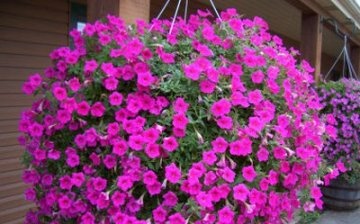Growing ampelous petunia
Ampel petunia has long hanging shoots, and will decorate any garden, balcony, window sill. But this plant is quite capricious, it has small tugovidny seeds, it is demanding on lighting and soil fertility. Growing ampelous petunia must begin with the correct choice of seeds. The fact is that in our country and other post-Soviet countries, the selection of petunias is not carried out, so you need to purchase seeds from a Western manufacturer. For sowing, prepare seedling boxes with loose, nutritious moist soil. Usually, sowing is done in March, so that flowering begins early, and the seedlings do not require additional illumination.
I use snow to distribute the seeds evenly over the soil surface. I spread the snowball on the surface of the ground, evenly distribute the seeds over it with a toothpick and wrap the box in polyethylene. The snow melts, moisturizes the soil, and the seeds end up on the surface of the earth. But you can use dry sand instead of snow. The soil in the resulting mini-greenhouse is moistened by spraying, and the greenhouse itself is kept on the window, in the light, petunia seeds germinate faster. When shoots appear, they should be regularly ventilated and condensate removed from the mini-greenhouse so that the ampelous petunia does not get sick with a black leg. To do this, it is enough to regularly turn the polyethylene to the other side.
When the seedlings get stronger and they have several leaves, they need to be planted in separate containers and begin to do foliar dressing with some kind of flower fertilizer about every three days. In open ground, seedlings can be planted when the threat of frost has passed. Then ampelous petunia will require weeding, loosening, watering and fertilizing at the same time as watering about twice a month. As you can see, caring for ampelous petunia is about the same as for other varieties of this wonderful plant.



